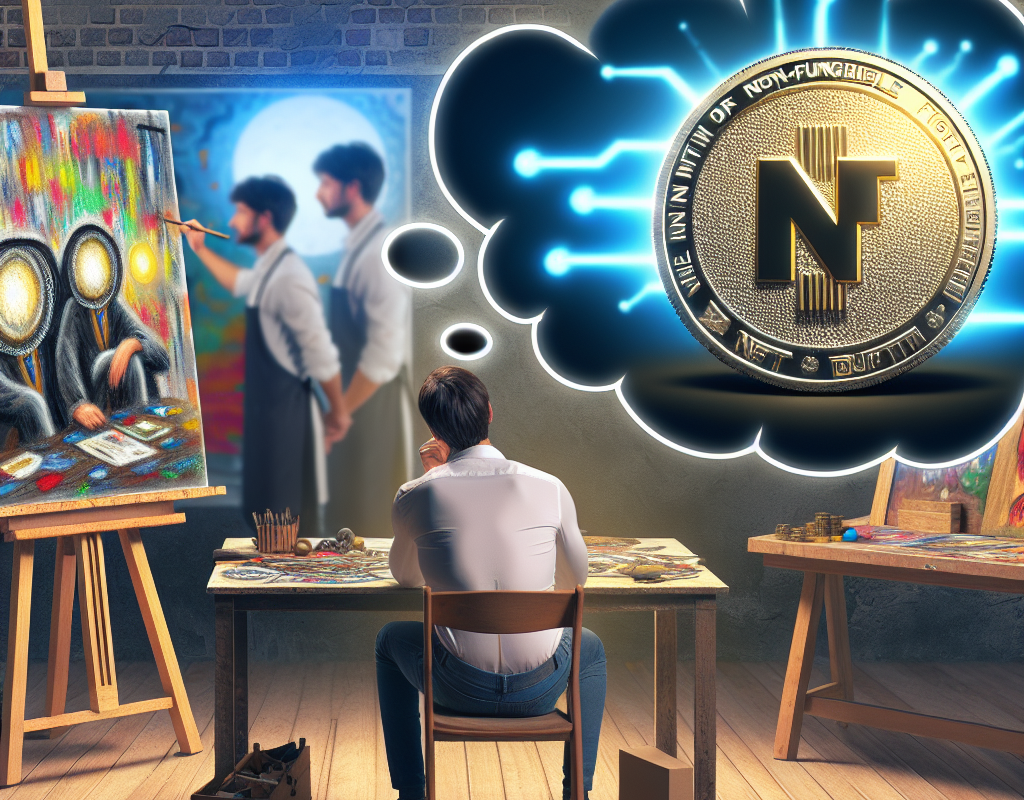
Should I Sell My Art as NFT? Is it Worth it?
The art world is buzzing with a new trend that has everyone asking, Should I sell my art as NFT? Non-fungible tokens, or NFTs, offer artists a novel way to showcase and monetize their creations. But what exactly are NFTs, and is this arena the right fit for you as an artist looking to explore new territories?
In this blog post, we’ll unravel the mystery behind NFTs, discuss their potential benefits and drawbacks for artists, and provide you with the insights needed to make an informed decision. So, let’s dive in and answer: Should I sell my art as NFT?

Understanding NFTs
Before deciding if you should sell your art as NFT, it’s crucial to grasp what NFTs are. Essentially, NFTs are unique digital assets stored on a blockchain. Unlike cryptocurrencies such as Bitcoin, which are identical and interchangeable, NFTs are one-of-a-kind. This uniqueness makes them perfect for representing ownership of digital art. When you sell your art as an NFT, you’re selling a digital certificate of ownership that can be bought, sold, or traded on various online platforms.
NFTs have revolutionized the way we think about digital ownership. For years, digital art was seen as easily replicable and difficult to monetize. However, with the advent of NFTs, artists can now create scarcity and value in the digital space, just like physical art. This innovation has opened up new possibilities for creators, making the digital art market more accessible and lucrative.
However, it’s essential to note that NFTs are not without controversy. Some critics argue that the environmental impact of blockchain technology, including the energy consumption involved in minting and trading NFTs, is a significant concern. Additionally, the legal and intellectual property aspects of NFTs are still evolving, which can pose challenges for artists looking to protect their work.
Key Benefits of Selling Art as NFTs
When considering whether to sell your art as an NFT, it’s important to weigh the advantages. One significant benefit is the potential for reaching a global audience. Traditional art markets are often limited by geography, whereas anyone with an internet connection can access NFTs. This global reach allows artists to connect with collectors worldwide, expanding their fan base and increasing sales opportunities.
Another advantage is the ability for artists to retain royalties on future sales. Traditionally, artists only receive payment once when they sell a piece. However, with NFTs, artists can embed smart contracts into their tokens, enabling them to receive a percentage of future sales. This feature ensures that artists can continue to benefit financially from the appreciation of their work over time.
NFTs also offer artists the opportunity to experiment with new forms of creativity. The digital nature of NFTs enables artists to explore multimedia, interactivity, and virtual reality, pushing the boundaries of traditional art forms. This freedom can lead to innovative and groundbreaking works that captivate audiences and generate excitement in the art world.
Drawbacks to Consider
While there are many benefits to selling your art as NFT, it’s essential to consider the potential drawbacks. One of the primary challenges is the volatility of the NFT market. Just like cryptocurrencies, the value of NFTs can fluctuate dramatically, making it difficult for artists to predict their earnings. This uncertainty can be daunting for those relying on their art as a source of income.
Another concern is the learning curve associated with NFTs and blockchain technology. For artists who are not tech-savvy, the process of minting and selling NFTs can be confusing and intimidating. It requires understanding various platforms, digital wallets, and transaction fees. Artists may need to invest time and effort into learning these technical aspects before entering the NFT market.
Additionally, the environmental impact of NFTs is a growing concern. The energy consumption associated with blockchain transactions, particularly on networks like Ethereum, has raised questions about the sustainability of NFTs. Environmentally conscious artists may need to carefully consider the ecological implications of their involvement in the NFT space.
How Should I Sell My Art as NFT?
If you’ve decided to sell your art as NFT, there are several steps to follow. First, choose a digital platform to mint and sell your NFTs. Popular platforms include OpenSea, Rarible, and Foundation. Research each platform’s features, fees, and audience to determine which aligns best with your goals.
Next, create a digital wallet to store your digital assets and cryptocurrency earnings. Platforms like MetaMask and Coinbase Wallet are commonly used in the NFT space. Ensure you have funds in your wallet to cover any minting fees, which are required to create your NFT on the blockchain.
Once your wallet is set up, you’ll need to mint your art as an NFT. This process involves uploading your digital artwork to the chosen platform and creating a unique token. Be sure to include detailed information about the artwork, such as title, description, and any additional media or content you wish to attach.
Finally, promote your NFT on social media and online communities to attract potential buyers. Building a strong online presence and engaging with collectors can increase the visibility and desirability of your NFTs. Remember, successful marketing is essential for driving sales and establishing your reputation in the NFT market.
Exploring NFT Art Platforms
When deciding where to sell your art as NFT, exploring various platforms is crucial. Each platform offers unique features, audiences, and fee structures. OpenSea, one of the largest NFT marketplaces, allows artists to list their NFTs without upfront costs, making it an attractive option for newcomers. Rarible, on the other hand, offers a more community-driven approach, enabling artists to participate in governance and earn royalties through its native token, RARI.
Foundation is another platform designed specifically for artists and creators. It focuses on supporting the creative community by providing tools for minting, promoting, and selling NFTs. Foundation’s curated approach ensures that artists are showcased alongside curated collections, attracting serious collectors and enthusiasts.
Other platforms worth exploring include SuperRare, KnownOrigin, and Mintable. Each of these platforms has its strengths and unique selling points, so take the time to research and choose the one that best aligns with your goals and artistic style.
Understanding the NFT Community
One of the exciting aspects of selling your art as NFT is becoming part of a vibrant and supportive community. The NFT space is filled with artists, collectors, and enthusiasts who are passionate about digital art and innovation. Engaging with this community can lead to valuable connections, collaborations, and opportunities for growth.
Participating in NFT-focused events, such as virtual exhibitions and conferences, allows you to showcase your work and connect with fellow artists and collectors. Additionally, joining online forums and social media groups dedicated to NFTs provides a platform for sharing ideas, gaining feedback, and staying updated on industry trends.
Building relationships within the NFT community can enhance your visibility and credibility as an artist. By actively participating and contributing to discussions, you can establish yourself as a respected figure in the NFT art world.
Navigating Intellectual Property Rights
When selling your art as NFT, it’s crucial to understand the intellectual property implications. NFTs represent ownership of a digital asset, but the artist typically retains the copyright to the artwork itself. This means you have the right to reproduce, distribute, and display your art, even after selling it as an NFT.
However, it’s essential to communicate your rights clearly to potential buyers. Consider including terms and conditions in your NFT listing that outline the scope of rights being transferred. This transparency helps set expectations and protects your intellectual property.
Additionally, keep in mind that NFTs are still a relatively new concept, and legal frameworks may vary. To ensure your rights are protected, consider consulting with an intellectual property lawyer who is familiar with blockchain technology and digital assets.
Pricing Your NFT Art
Determining the right price for your NFT art can be a challenge. Unlike traditional art markets, the value of NFTs is often influenced by factors such as scarcity, demand, and the reputation of the artist. To set a competitive price, research recent sales of similar artworks and analyze market trends.
Consider starting with a lower price for your early NFTs to attract buyers and build your reputation. As your work gains recognition and demand increases, you can gradually raise your prices. Additionally, leverage the royalty feature in your NFTs to ensure you receive compensation for future sales.
Experimentation is also key when pricing your NFT art. Test different pricing strategies, such as auctions or limited editions, to gauge buyer interest and optimize your earnings.
Building Your Personal Brand as an NFT Artist
To succeed in the NFT art market, it’s essential to build a strong personal brand. Your brand represents your unique artistic style, values, and story. Cultivate a cohesive online presence that reflects your identity and resonates with your target audience.
Create a professional website or portfolio showcasing your NFT art and providing information about your creative process and inspiration. Regularly update your social media profiles with engaging content, such as behind-the-scenes glimpses of your artwork, artist statements, and interactions with your audience.
Networking with other artists and collaborating on projects can also enhance your brand visibility. By aligning yourself with reputable artists and participating in collaborative initiatives, you can leverage their networks and gain exposure to new audiences.
Leveraging Social Media for NFT Art Promotion
Social media platforms are crucial in promoting your NFT art and engaging with your audience. Platforms like Twitter, Instagram, and TikTok offer unique opportunities to showcase your work, share your creative journey, and connect with potential buyers.
When promoting your NFT art on social media, focus on providing value to your audience. Share insights into your artistic process, offer tips and tutorials, and engage with your followers by responding to comments and messages. Building a genuine connection with your audience fosters loyalty and encourages them to support your NFT art.
Collaborate with influencers and established NFT artists to expand your reach and tap into their networks.
Conclusion
So, this was a detailed answer to: should I sell my art as NFT? Deciding whether to sell your art as NFT is a personal choice that depends on your goals, values, and artistic style. NFTs offer exciting opportunities for artists to reach global audiences, retain royalties, and explore new creative possibilities. However, it’s essential to consider the challenges, such as market volatility and environmental impact, before taking the plunge.

